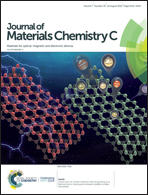A facile strategy for the synthesis of water-soluble fluorescent nonconjugated polymer dots and their application in tetracycline detection†
Abstract
Developing fluorophores and realizing sensitive tetracycline (TC) detection using a facile and economical process are of great significance for chemical and biological sensing, but challenges still remain. In this paper, water-soluble non-conjugated polymer dots (NCPdots) with strong blue-green fluorescence emission were prepared from polyethyleneimine (PEI) and L-ascorbic acid (AA) via the Maillard reaction and self-assembly. The synthesis of PEI–AA NCPdots was carried out in an aqueous medium at room temperature via a one-pot reaction, which is very facile and environmentally friendly. The PEI–AA NCPdots can be incorporated into poly(vinyl alcohol) (PVA) to form a fluorescent PEI–AA NCPdot/PVA polymer composite film through a simple drop-coating method. Also, the fundamental properties (such as excitation-dependent fluorescence and high stability) and the origin of intrinsic fluorescence were discussed and explored. The PEI–AA NCPdots were then used as fluorophores for fast, sensitive, and selective detection of TC via an inner filter effect process. As little as 10 nM TC could be detected. Finally, the developed sensor was successfully applied for the determination of TC in real milk samples and river water.



 Please wait while we load your content...
Please wait while we load your content...